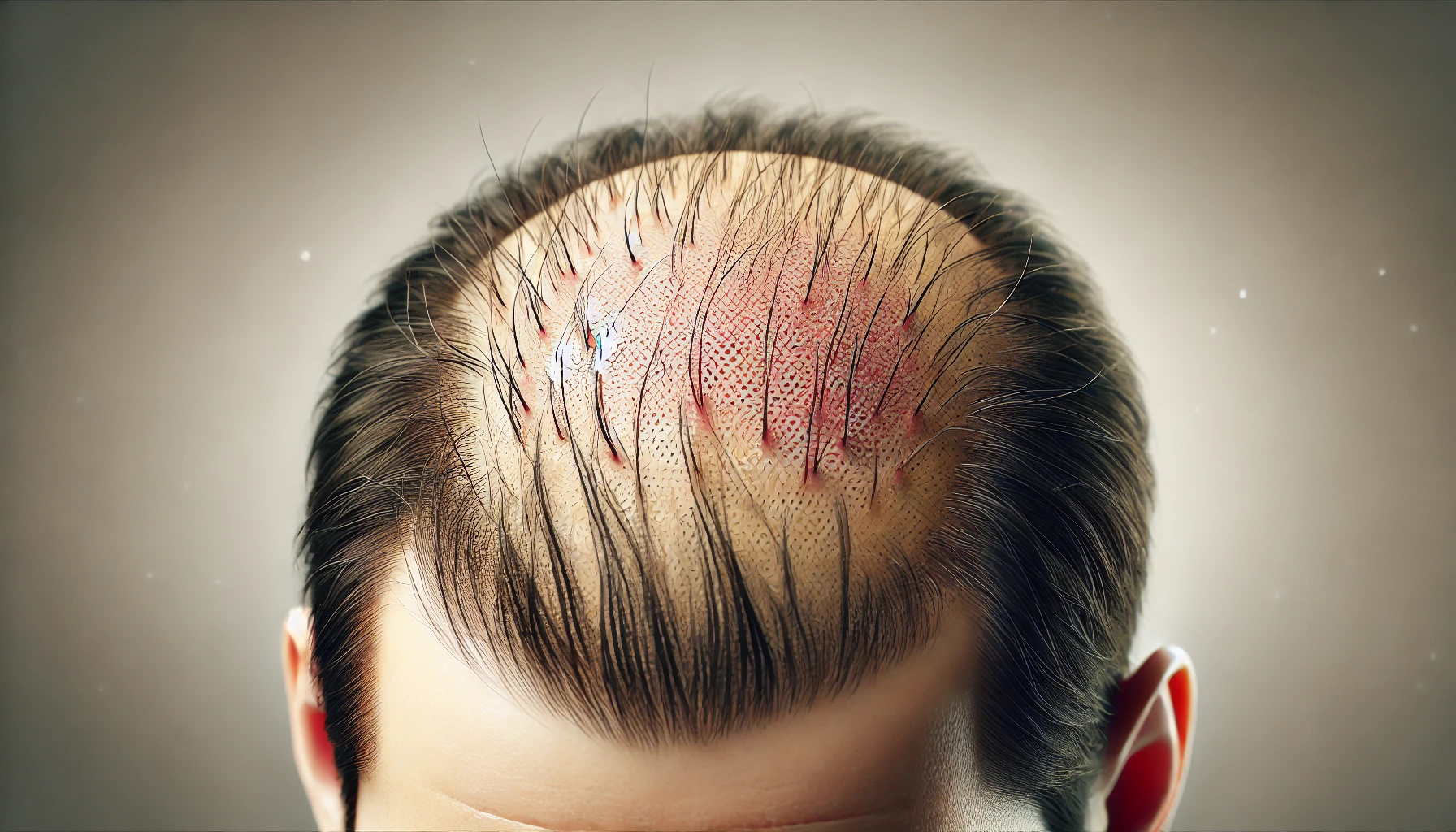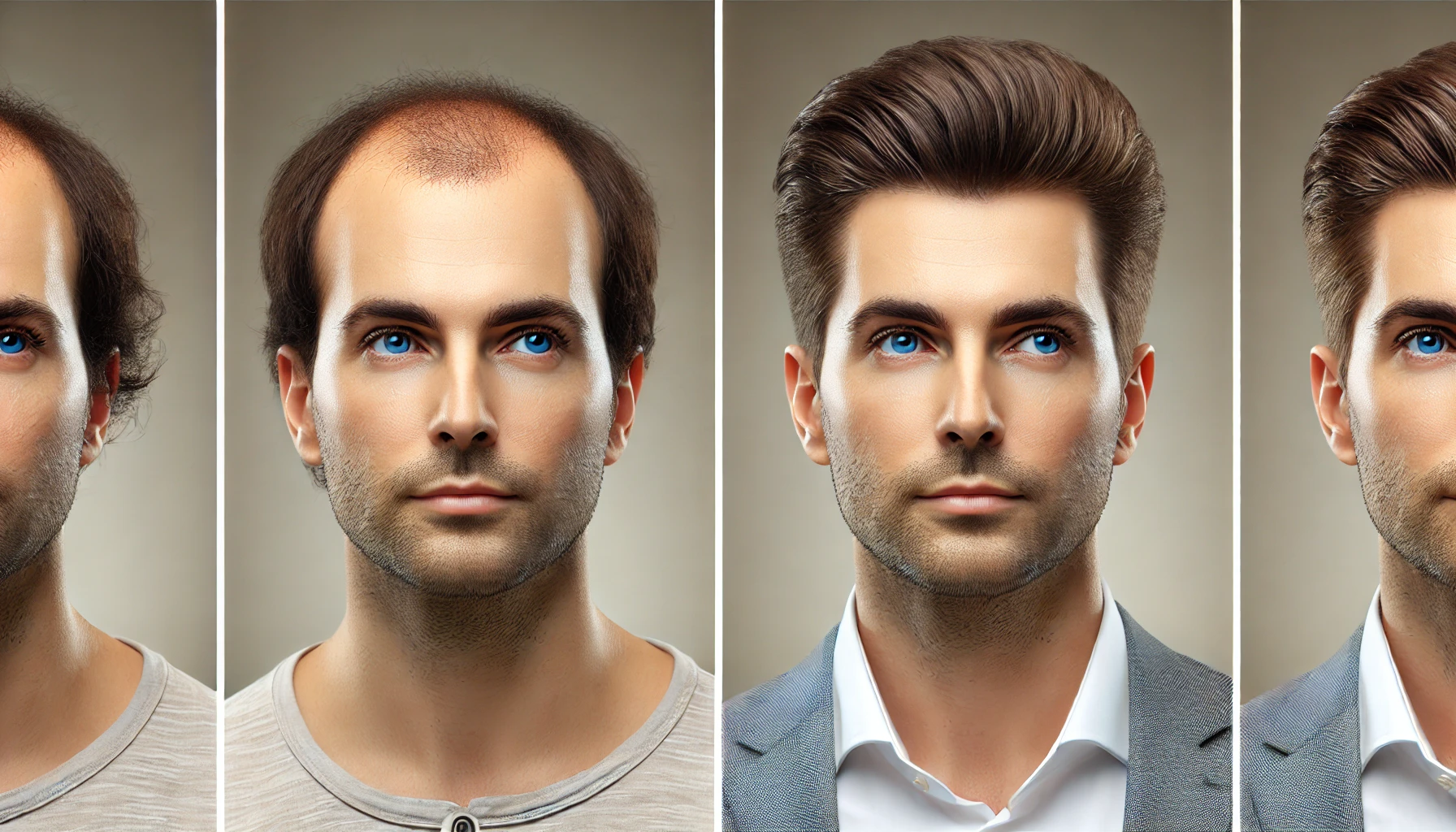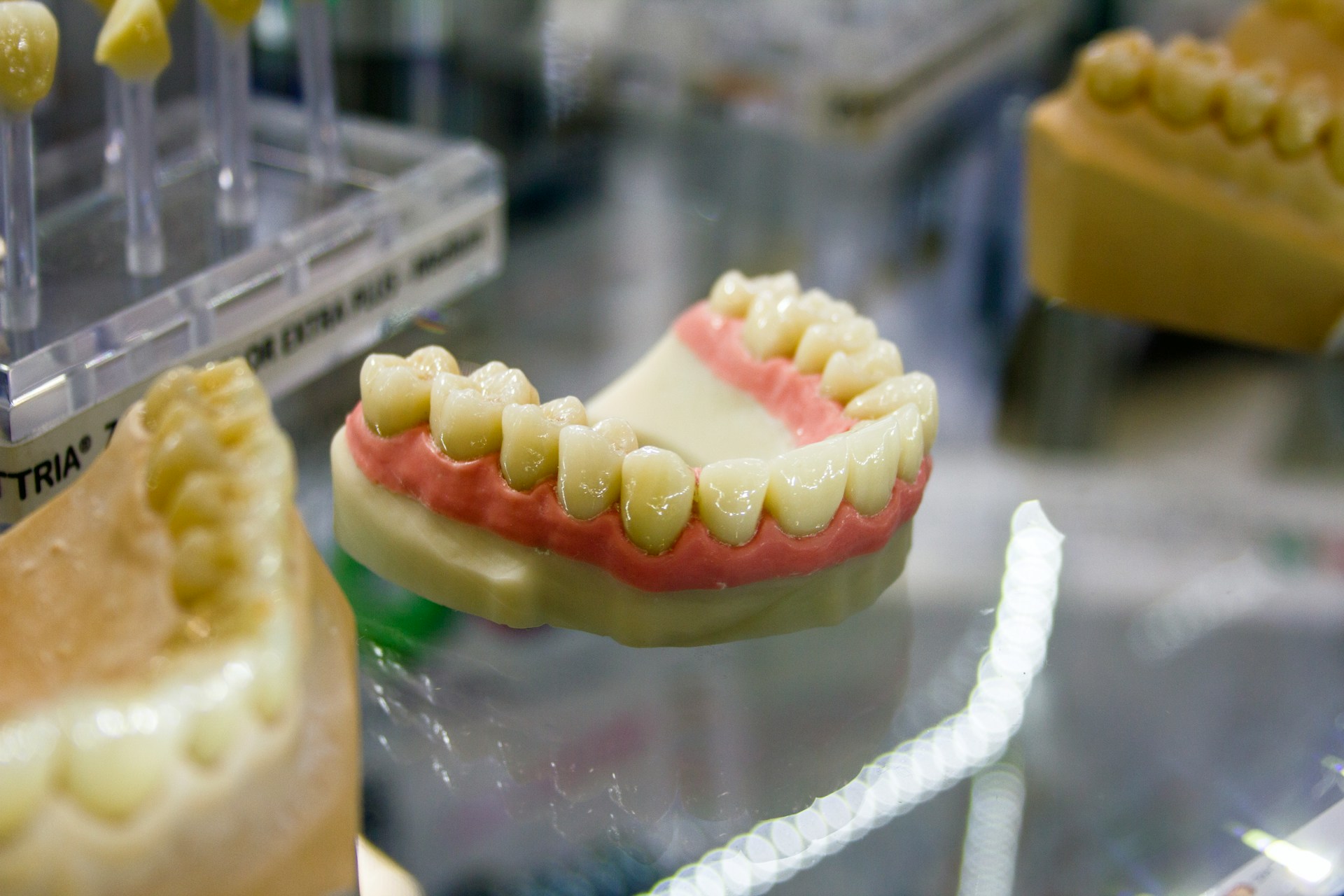This guide will provide you with all the essential information you need, covering the various types of procedures available, such as FUE, FUT, and the ARTAS robotic technique, as well as the important factors to take into account before making your decision. See stunning Hair Transplants Before and After results to help visualize what’s possible.
It will outline the step-by-step process of a hair transplant, what results you can expect, recovery tips, and guidance on selecting the right hair transplant clinic for your needs.
Additionally, you’ll find real-life transformations that may inspire your journey toward achieving a fuller head of hair!
What Is a Hair Transplant?

A hair transplant is a surgical procedure intended to restore hair to areas of the scalp that have experienced thinning or baldness as a result of hair loss.
This process involves moving hair follicles from a donor site, typically located at the back of the head, to areas affected by hair loss. The technique enhances hair density while achieving a natural appearance, making it a highly sought-after solution. While the price of a hair transplant can vary depending on the clinic, technique, and extent of the procedure, many individuals find it to be a worthwhile investment for its effectiveness and long-lasting results.
With the growing number of people seeking solutions for hair loss, hair transplants continue to gain popularity as a reliable and transformative option.
What Are the Different Types of Hair Transplant Procedures?
There are various types of hair transplant procedures available today, each with its own set of benefits and techniques designed to address different hair loss conditions.
If you are contemplating options such as Follicular Unit Extraction (FUE), Follicular Unit Transplantation (FUT), Direct Hair Implantation (DHI), or the advanced ARTAS Robotic Hair Transplant, it’s essential to separate facts from myths about hair transplants. Misconceptions often deter individuals from considering these transformative procedures, despite their proven effectiveness and safety.
Gaining a clear understanding of these options can help you make an informed decision about your hair restoration journey, ensuring your choice aligns with your needs and goals.
1. FUE (Follicular Unit Extraction)
Follicular Unit Extraction (FUE) is a minimally invasive hair transplant technique that involves the extraction of individual hair follicles from the donor area and their subsequent transplantation to the balding areas of the scalp. This innovative method offers a more natural appearance and quicker recovery times compared to traditional techniques, making it a preferred choice for many individuals considering hair restoration.
Utilising advanced tools, the FUE method ensures precision in the harvesting of hair follicles, which helps to minimise trauma to the surrounding tissue. This careful extraction process not only maintains the integrity of the donor site but also enhances the overall aesthetic outcomes.
In contrast to strip harvesting, which may leave obvious scars, FUE results in tiny, inconspicuous dots that tend to heal well over time. Patients generally notice an improvement in hair density as the transplanted follicles adapt to their new environment, leading to fuller and more natural hair growth in the long term.
The smooth transition and lasting effects of FUE make it an appealing option for those seeking effective solutions for hair restoration.
2. FUT (Follicular Unit Transplantation)
Follicular Unit Transplantation (FUT) is a well-established hair transplant method in which a strip of scalp is removed from the donor area, allowing individual hair follicles to be transplanted into thinning or balding regions. While this technique can achieve impressive hair density and coverage, it typically involves a longer recovery period and may result in a linear scar.
During the surgical procedure, a physician carefully excises a strip of tissue from the back of the scalp, an area known for its abundance of healthy hair follicles. This harvested strip is then meticulously divided into smaller follicular units, all under a microscope to ensure precision.
The careful implantation of these units into the balding areas not only enhances hair density but also improves the overall aesthetic appearance of the hairline. Many patients report high levels of satisfaction with their results; however, it is crucial to consider potential risks, including post-operative discomfort, infection, and scarring.
Recovery from the procedure can take several weeks, during which patients may experience hair shedding before the new growth starts to appear. Having a clear understanding of the FUT process give the power tos potential candidates to make informed decisions about their hair restoration journey.
3. DHI (Direct Hair Implantation)
Direct Hair Implantation (DHI) is a sophisticated hair restoration technique that facilitates the direct placement of hair follicles into the recipient area without the need for incisions or stitches. This method enhances the precision of hairline design and significantly reduces recovery time, making it an attractive option for those seeking immediate results.
In contrast to traditional transplantation methods, DHI utilises a specialised tool that ensures each graft is placed at the optimal depth and angle, resulting in a more natural appearance. The technology minimises trauma to the scalp, which leads to greater patient satisfaction by reducing post-operative discomfort and swelling.
DHI also boasts a high survival rate for transplanted follicles, maximising hair density and overall restoration outcomes. For individuals considering effective solutions for hair loss, DHI represents a noteworthy advancement in hair restoration technology, offering not only aesthetic benefits but also peace of mind throughout the recovery process.
4. ARTAS Robotic Hair Transplant
The ARTAS Robotic Hair Transplant system employs advanced robotics and artificial intelligence to automate the hair transplant process, ensuring enhanced precision in both follicle extraction and placement. This innovative technology not only improves the overall success rate but also reduces the risks commonly associated with traditional surgical procedures.
Utilising state-of-the-art imaging and mapping technology, the ARTAS system accurately identifies the healthiest hair follicles for extraction, significantly increasing the viability of the transplanted hairs. In contrast to manual techniques, which can be susceptible to human error and lead to inconsistent results, this robotic system provides a more uniform and natural appearance.
Patients experience quicker recovery times, reduced discomfort, and techniques that are significantly less invasive, resulting in a smoother overall experience during the procedure.
Ultimately, the emotional benefits of successfully restoring one’s hair can greatly boost self-esteem, fostering a renewed sense of confidence and enhancing quality of life.
What Are the Factors to Consider Before Getting a Hair Transplant?

Before deciding to undergo a hair transplant, it is important to take into account several factors that can influence both your eligibility for the procedure and its overall success.
Understanding your specific hair loss pattern, the availability of donor hair, and any underlying health conditions can greatly affect your hair restoration journey and the results you can expect.
1. Hair Loss Pattern
Identifying your hair loss pattern is a crucial step in determining the most suitable hair restoration strategy. Hair thinning patterns can differ from person to person and may be influenced by genetic factors, which can, in turn, affect both the extent of hair loss and the success of a hair transplant.
Understanding these variations in hair loss is essential for individuals considering surgical options. For example, traits such as male or female pattern baldness often arise from hereditary influences, and recognising these patterns can significantly enhance treatment outcomes.
Moreover, this genetic predisposition plays a critical role in how sensitive hair follicles are to hormones, making personalised assessments particularly important. By evaluating individual patterns and their hereditary roots, healthcare professionals can formulate tailored treatment plans that optimise hair restoration efforts.
This approach ultimately leads to a higher success rate and more satisfying results for those seeking to regain their hair.
2. Donor Hair Availability
The availability of donor hair is a crucial factor that significantly influences the success of a hair transplant procedure. Having enough donor hair is essential for achieving the desired hair density and ensuring a natural appearance. Therefore, it is important for potential candidates to evaluate their donor areas before moving forward with the procedure.
Hair follicles harvested from the donor site must be both high quality and plentiful enough to meet the specific requirements of the recipient area. Candidates with thicker hair or a denser donor area are likely to experience more favourable outcomes, as this can greatly enhance the overall fullness of the transplanted hair.
Additionally, the health and characteristics of the donor hair are vital, as they directly affect the viability and aesthetic appeal of the hair grafts after transplantation. Consequently, understanding one’s own donor hair availability and quality can significantly improve the chances of achieving satisfactory results in the hair restoration journey.
3. Health Conditions
Certain health conditions can affect a person’s eligibility for hair transplant procedures, making it essential to discuss any existing medical issues with a hair specialist. Conditions such as diabetes, autoimmune disorders, or skin issues can influence both the surgical process and the recovery period.
For example, individuals with diabetes may experience delayed healing and an increased risk of infection, which can complicate their recovery timeline after surgery. Similarly, those with autoimmune disorders may have unpredictable responses to the procedure, potentially resulting in adverse outcomes such as graft rejection.
Additionally, skin conditions like psoriasis or eczema can present challenges during the transplant, as inflamed areas may complicate the harvesting and implantation of hair follicles.
It’s important to recognise that patient safety should always be the top priority; therefore, comprehensive pre-surgical evaluations are crucial for tailoring the procedure to fit each individual’s unique health profile.
What Are the Steps of a Hair Transplant Procedure?

The hair transplant procedure generally consists of several important steps that contribute to a successful outcome for individuals seeking to restore their hair.
It begins with an initial consultation and evaluation, where candidates discuss their goals and assess their suitability for the procedure.
Following this, hair follicles are harvested and then implanted into the desired areas. Understanding each of these stages is crucial for anyone preparing for their hair restoration journey.
1. Consultation and Evaluation
The consultation and evaluation stage is essential for individuals considering a hair transplant, as it provides an opportunity to discuss their hair loss concerns with specialists and receive expert advice on the most suitable options.
During this session, candidates undergo a comprehensive assessment to determine their eligibility for various hair transplant procedures.
This process not only creates a welcoming environment for candidates to express their concerns but also builds trust between them and the specialist. Candidates can expect a thorough examination that considers factors such as the extent of their hair loss, the availability of donor hair, and their overall health. These evaluations are crucial, as they help shape personalised treatment plans that address individual needs.
Tailored approaches significantly impact the success of hair restoration, ensuring that the selected method aligns with the candidate’s goals while maximising natural-looking results. By prioritising these consultations, candidates can make informed decisions, ultimately leading to better outcomes.
2. Preparing the Donor Area
Preparing the donor area is a vital step in the hair transplant process, as it ensures that hair follicles can be harvested efficiently while minimising trauma to the scalp. This preparation typically includes shaving the hair, cleaning the area, and administering local anaesthesia to improve the patient’s comfort and overall experience during the procedure.
These steps are not just procedural; they play a crucial role in facilitating a smoother extraction and promoting quicker healing post-surgery. Surgeons often use techniques such as Follicular Unit Extraction (FUE) or Follicular Unit Transplantation (FUT), which are tailored to meet each patient’s unique characteristics and needs.
By carefully planning the harvesting process, the surgical team can minimise the risk of damage to surrounding hair and scalp tissue. Additionally, prioritising patient comfort through effective anaesthesia and maintaining a well-organised environment can significantly reduce anxiety and enhance overall satisfaction with the procedure, ultimately making it a positive experience.
3. Harvesting the Hair Follicles
Harvesting hair follicles is a critical phase in hair transplant procedures, where practitioners utilise either Follicular Unit Extraction (FUE) or Follicular Unit Transplantation (FUT) to collect healthy hair follicles for transplantation. This step demands a high level of precision and expertise to ensure that the follicles remain viable for successful regrowth.
Both techniques offer unique approaches to harvesting that can greatly affect overall patient outcomes. With FUE, individual follicular units are extracted directly from the scalp, resulting in minimal scarring and a quicker recovery time. On the other hand, FUT involves removing a strip of scalp from which follicles are extracted. While this method typically leads to a linear scar, it may yield a higher number of grafts.
It is essential for patients to understand these methods, as each has its advantages and limitations that not only impact the immediate results but also influence long-term satisfaction with the hair transplant. Ultimately, the choice of harvesting method can significantly affect both the density and the natural appearance of the transplanted hair.
4. Preparing the Recipient Area
Preparing the recipient area is a vital step that involves designing the ideal hairline and ensuring that the scalp is ready for the implantation of harvested hair follicles. This careful process lays the groundwork for achieving the most natural-looking results after the transplant.
A well-executed hairline design not only enhances the overall aesthetic but also plays a significant role in framing the face and restoring confidence. Surgeons consider factors such as the patient’s age, facial structure, and personal preferences when crafting the hairline, ensuring it appears harmonious and appropriate for their age.
To achieve precision during the procedure, techniques such as marking the donor and recipient sites with a specialised pen are employed. Additionally, gentle scalp preparation is essential to minimise trauma to the hair follicles during implantation. This level of attention to detail can greatly influence the final outcome, resulting in a more natural appearance that blends seamlessly with existing hair.
5. Implanting the Hair Follicles
The final step in the hair transplant procedure involves the careful implantation of harvested hair follicles into the designated recipient area. This stage requires precision to ensure optimal placement for natural growth. Depending on the method employed, the surgeon meticulously inserts each follicle to achieve a seamless blend with the existing hair.
This intricate task necessitates a high level of skill and experience, as even slight misplacement can disrupt the desired aesthetic outcome. Techniques such as follicular unit extraction (FUE) and follicular unit transplantation (FUT) each come with specific requirements for ensuring that the follicles are aligned correctly and positioned at the proper angle to mimic natural hair growth.
By carefully placing each follicle, the hair restoration expert not only enhances the density of the transplanted area but also significantly increases the likelihood of successful integration with the surrounding hair. This attention to detail ultimately contributes to a more harmonious and natural appearance after the surgery.
What Are the Expected Results and Recovery Process?

After undergoing a hair transplant, it is important for candidates to understand what results to expect and the recovery process involved.
While outcomes can differ from person to person, most patients can anticipate noticeable hair regrowth within a few months following the surgery.
Adhering to post-transplant care instructions is crucial and significantly impacts the overall success of the procedure.
1. Hair Growth Timeline
The timeline for hair growth after a hair transplant can differ from person to person, but typically, patients can expect to see initial signs of hair regrowth within a few months. Achieving full results may take up to a year, so it is important to practise patience as the hair follicles continue their growth cycle.
In the first few weeks following the procedure, it is common for the transplanted hair to shed, a phenomenon often referred to as shock loss. While this temporary phase can be discouraging, it is a normal and expected part of the hair regrowth journey.
As the months go by, new hair begins to emerge gradually. By around the six-month mark, many individuals notice that their hair appears thicker and fuller, with continued improvement anticipated in the subsequent months.
Understanding this timeline is essential, as it helps in managing expectations and maintaining a positive outlook, ultimately enhancing the overall experience of witnessing the results of a hair transplant.
2. Post-Transplant Care Tips
Post-transplant care plays a vital role in ensuring optimal recovery and successful hair regrowth following a hair transplant. Patients should adhere to specific post-transplant care tips, such as avoiding strenuous activities, protecting the scalp from sun exposure, and following any prescribed hair care routines.
Maintaining a balanced diet that is rich in vitamins and minerals can significantly enhance healing and promote hair growth. Staying well-hydrated is also essential, as it supports overall health and nourishes the hair follicles during this critical recovery phase.
It is important to attend follow-up appointments scheduled with the healthcare provider to closely monitor the healing process. Additionally, avoiding harsh hair products and refraining from using styling tools during the initial weeks will help protect the delicate new grafts.
Once the healing period is over, gentle scalp massages can help stimulate blood circulation and further aid in hair development.
Real Transformations: Before and After Hair Transplant Photos
Hair transplants can result in remarkable transformations, and many individuals take the time to share their before and after photos to demonstrate the impressive outcomes they have achieved.
These testimonials and patient narratives emphasise not just the aesthetic enhancements but also the significant boost in confidence that often accompanies successful hair restoration.
1. Male Hair Transplant Transformations
Male hair transplant transformations often showcase significant changes, with before pictures displaying considerable hair loss and after pictures revealing a full, natural-looking hairline. These visual testimonials can serve as a source of inspiration for other men facing similar hair loss challenges.
Common patterns of hair loss in men, such as receding hairlines and thinning crowns, can greatly affect self-esteem and confidence levels. Many men find themselves seeking solutions to address these issues, and hair transplants have become a popular option.
For example, one case study focused on a young man in his late twenties who went from extensive hair thinning to achieving a youthful, vibrant appearance following his procedure. Another example featured an older gentleman whose hair restoration journey significantly transformed his image, demonstrating that it is never too late to seek out solutions.
These compelling before and after pictures not only illustrate the physical change but also capture the renewed sense of confidence that many men experience after surgery.
2. Female Hair Transplant Transformations
Female hair transplant transformations yield impressive results, with before pictures often showing thinning hair or bald patches, while after pictures showcase restored hair density and a rejuvenated appearance. These transformations give the power to women to take control of their hair restoration journeys.
Many women face hair loss due to various factors, including hormonal changes, stress, or genetics, which can lead to a decline in self-esteem. By examining case studies that highlight remarkable before and after outcomes, one can truly appreciate the significant impact these procedures have on confidence levels.
The emotional significance of a successful hair transplant is evident in the joy and relief expressed in post-procedure images. This transformation reflects not only an aesthetic improvement but also a personal victory over the challenges of hair loss. Each journey is unique, yet they collectively tell a powerful story of resilience and rediscovery.
How to Choose the Right Hair Transplant Clinic?

Selecting the appropriate hair transplant clinic is a vital step in the hair restoration journey, and it necessitates thorough research and thoughtful consideration of several factors.
By reading reviews and examining the surgeon’s credentials, individuals can develop a comprehensive understanding of their options. This careful approach can ultimately lead to a more satisfying patient experience and achieve the desired results.
1. Research and Read Reviews
Conducting thorough research and reading reviews from previous patients is a crucial initial step when seeking a reputable hair transplant clinic. Insights into patient satisfaction and testimonials can reveal the quality of care and the results one might expect from various clinics.
Understanding the experiences of others can assist prospective patients in assessing the reliability of different providers. When evaluating a clinic, it is advisable to look for patterns in the feedback, such as the professionalism of the staff, the transparency of the procedures, and the overall patient outcomes.
Authentic reviews often illuminate important aspects like post-operative care and the effectiveness of communication between clinicians and patients. By carefully considering this feedback, individuals can make more informed decisions, thereby enhancing their chances of achieving the desired hair restoration results while ensuring their comfort and confidence throughout the process.
2. Check the Surgeon’s Credentials
Checking the credentials of a surgeon is crucial to ensure that you are receiving care from a qualified and experienced professional in the field of hair restoration. A surgeon’s expertise can greatly impact the success of the hair transplant procedure as well as the overall patient experience.
It is advisable to look for board certifications in dermatology or plastic surgery, as these certifications indicate a strong foundation in relevant medical practices. Additionally, reviewing the surgeon’s training background is important; many surgeons complete specialised fellowships that focus on hair transplantation techniques.
Experience is another key factor—consider how many procedures they have performed and their success rates with various hair restoration methods.
Reputable hair transplant clinics are typically more than willing to provide this information, demonstrating their commitment to ensuring that patients receive care from skilled experts. Ultimately, making an informed choice enhances the likelihood of achieving optimal results.
3. Request for Before and After Photos
Requesting before and after photographs from potential hair transplant clinics can offer valuable insights into the results you might expect and the overall effectiveness of the clinic’s hair restoration procedures. These visual testimonials can help validate the clinic’s claims, instilling greater confidence in your decision.
These images often reflect real patient experiences, showcasing genuine transformations that resonate with individuals considering similar procedures. By examining the journeys of others, prospective patients can gain a clearer understanding of what to expect during the hair restoration process, including healing timelines and hair growth patterns.
Observing the tangible differences captured in these photographs not only inspires hope but also reinforces the notion that successful results are achievable, enhancing one’s confidence in the decision-making process.
Whether you are seeking subtle enhancements or more dramatic transformations, real-life examples can significantly assist in navigating the available options.
4. Inquire About the Procedure and Aftercare
Inquiring about the details of the hair transplant procedure and the necessary aftercare is essential for ensuring a smooth recovery and satisfactory results. It is important for any hair transplant candidate to have a clear understanding of what to expect during the procedure as well as the post-operative care involved.
Patients should feel encouraged to ask specific questions about the entire process. This includes understanding the potential risks, the expected recovery timeline, and any aftercare recommendations that may be needed to promote healing.
Engaging in these discussions is beneficial for setting realistic expectations regarding outcomes, which in turn significantly enhances the overall patient experience.
Additionally, it is crucial for individuals to discuss options for pain management and the types of medications they can expect. This preparation ensures that they are fully equipped for both the procedure itself and the days that follow, further underscoring the importance of thorough inquiries in patient care.
Frequently Asked Questions on Hair Transplants Before and After
What is a hair transplant?
A hair transplant is a surgical procedure where hair follicles are taken from one part of the body (typically the back or sides of the head) and transplanted to areas where there is thinning or balding. This can help restore hair growth and improve the overall appearance of the hair.
How do I know if I am a good candidate for a hair transplant?
The best way to determine if you are a good candidate for a hair transplant is to consult with a qualified and experienced hair transplant surgeon. They will evaluate your hair loss and overall health to determine if a hair transplant is the best option for you.
What are the benefits of a hair transplant?
A hair transplant can provide a permanent solution for hair loss, improve self-confidence and self-esteem, and create a more youthful appearance. It is a safe and effective procedure with minimal downtime and natural-looking results.
Are there any risks or side effects associated with hair transplants?
As with any surgical procedure, there are risks and potential side effects involved with hair transplants. These can include bleeding, infection, scarring, and temporary numbness or discomfort. However, these are rare and can be minimised by choosing a skilled surgeon and following post-operative care instructions.
How long does it take to see results from a hair transplant?
The timeline for seeing results from a hair transplant can vary depending on the individual and the specific procedure used. In general, it can take several months for the transplanted hair to start growing, and up to a year for the full results to be visible. Patience is key, as the final outcome can be worth the wait.
Are the before and after photos of hair transplants accurate representations?
Yes, the before and after photos of hair transplants are real and accurate representations of the results that can be achieved. However, it’s important to note that results may vary for each individual and it’s important to have realistic expectations when undergoing a hair transplant procedure.







